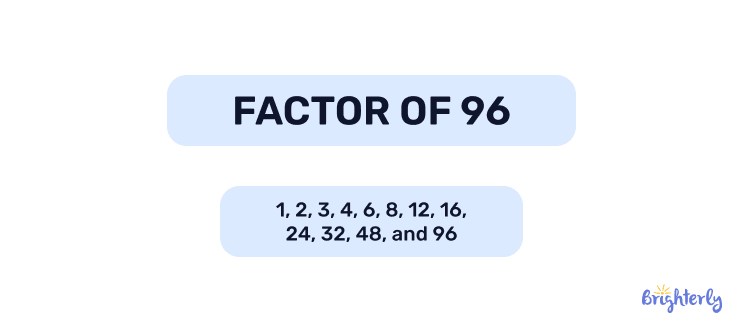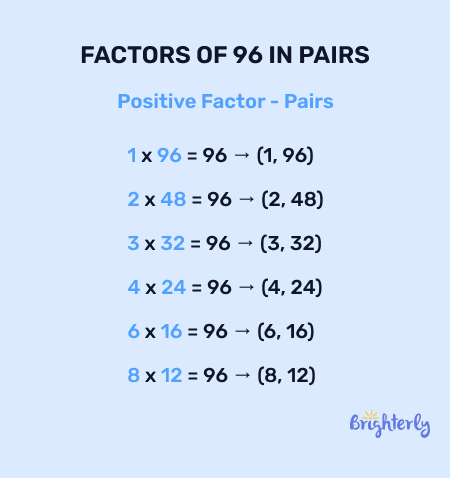Factors of 96 – Definition With Examples
Updated on December 1, 2025
Factors are a key piece of the math puzzle, making up larger numbers and containing a number of fascinating properties. They help you work with division and multiplication more easily, and even have a key connection to the times tables.
All numbers have factors, but some will have more than others. Here, we’re going to explore the factors of the number 96 to improve your understanding of factors. We’ll cover the definition of this concept, all the different factors of 96 (including prime and composite) and their properties, plus factors of 96 in pairs. We’ll also share some practice problems so you can test yourself on the number 96 and its factors.
What are factors of 96?
Factors of 96 are whole numbers (aka integers) that can be multiplied to make 96. The factors for 96 are:
- 1
- 2
- 3
- 4
- 6
- 8
- 12
- 16
- 24
- 32
- 48
- 96
If you’re wondering, “What equals 96?”, the answer is: each of these numbers, multiplied by its factor pair, gives 96.

Definition of factors
A factor is a whole number that can be multiplied by other whole numbers to equal a given number. In this case, the given number is 96, so all these numbers can be multiplied to give us 96. The numbers that can be multiplied together to make our given number are called factor pairs. This also means that your given number can be divided by these numbers with no remainder.
Properties of factors of 96
There are some interesting properties attached to each factor of 96 that we’ll go through. But first, let’s divide them into prime factors (factors that are prime numbers) and composite factors (factors that also have factors beyond 1 and themselves).
a. Prime factors of 96
96 has only two prime factors: 2 and 3. This means that these numbers are only divisible by themselves and 1. These two numbers have some interesting properties:
- 2 is the smallest prime number and the smallest even number
- 3 is the first odd prime number and also the smallest number that forms a triangular shape.
b. Composite factors of 96
The remaining factors for 96 are composite, meaning they have their own factors. Being composite numbers doesn’t mean they don’t have their own fascinating properties, so let’s take a look at some of them!
- 4 is a square number (the result of multiplying a number by itself — here, that number is 2)
- 6 is the smallest perfect number after 1 (a number equal to the sum of its divisors — here, they are 1, 2, and 3)
- 8 is the second smallest cube number after 1 (the result of multiplying a number by itself three times — that number is again 2)
- 12 is a Harshad number (a number divisible by the sum of its digits — here, that is 1 and 2, which makes 3)
- 16 is another square number, and a fourth power (the result of multiplying a number by itself four times, which is again the number 2)
- 24 is another Harshad number, meaning it is divisible by the sum of its digits 2 and 4
- 32 is a fifth power (the result of multiplying a number by itself five times — you guessed it, that’s the number 2 again!)
- 48 has 10 factors
- 96 is a practical number (meaning every integer between 1 and 96 can be expressed as a sum of the factors of 96)
That leaves us with number 1, which is neither prime nor composite. 1 is the multiplicative identity, which means that when it is multiplied by another number, the result will always be that number
Difference between prime and composite factors of 96
The difference between the prime and composite factors of 96 is the set of factors. A prime factor does not have any factors except for 1 and itself — this is true of the prime factors of 96, which are 2 and 3. Their factors are:
- 2: 1 and 2
- 3: 1 and 3
Meanwhile, the composite factors of the number 96 all have their own factors in addition to 1 and themselves:
- 4: 1, 2, and 4
- 6: 1, 2, 3 and 6
- 8: 1, 2, 4, and 8
- 12: 1, 2, 3, 4, 6, and 12
- 16: 1, 2, 4, 8, and 16
- 24: 1, 2, 3, 4, 6, 8, 12, and 24
- 32: 1, 2, 4, 8, 16, and 32
- 48: 1, 2, 3, 4, 6, 8, 16, 24, and 48
- 96: 1, 2, 3, 4, 6, 8, 12, 16, 24, 32, 48, and 96
Factors of 96 in pairs
All factors can be put into factor pairs. That’s because when multiplied to give your given number, they need to be multiplied by another number. The factor pairs of 96 are:
- 1 and 96
- 2 and 48
- 3 and 32
- 4 and 24
- 6 and 16
- 8 and 12

You can also find the factors of -96 and factor pairs of -96 by making one number in your pair a negative number.
Divisibility rules related to factors of 96
An easy way to work out the factors of 96 is to think about the divisibility rules of the number. For example, since it ends in an even digit, it is an even number and therefore divisible by 2. Similarly, its two digits can be added up to a multiple of 3, meaning it is also divisible by 3.
Practice problems on factors of 96
Now it’s your turn — with your newfound knowledge on 96 factors, try out the practice problems below. You can use a pen and paper to work out and write down your answers. These questions will help you prepare for future tests and help you become familiar with solving factor problems.
- What is the prime factorization of 96?
- Is 48 a factor of 96? Answer and show your workings.
- Identify the common factors of 96 and 64 and write them down.
Conclusion
Here, we have covered all the factors of the number 96 and answered questions, including “What makes 96?” “What are the prime factors of 96?” and “What are the factor pairs of 96?” Now, you can confidently list and work with all the factors of the number 96, which gives you confidence in multiplication and division and helps you remember your times tables more easily!
Frequently asked questions on factors of 96
What are the factors of 96?
All factors of 96 are:
- 1
- 2
- 3
- 4
- 6
- 8
- 12
- 16
- 24
- 32
- 48
- 96
This means that these numbers can be used to divide the number 96 with no remainders, and they can be multiplied by other integers (their factor pairs) to make 96.
Is 96 a prime number?
No, 96 is not a prime number. A prime number only has two factors: 1 and itself. Because 96 has more factors, this means it is a composite number.
What is the prime factorization of 96?
The prime factorization of 96 is 2 x 2 x 2 x 2 x 2 x 3 (or 25 x 3). To find 96 prime factorization, divide 96 by its smallest prime factor (2) and continue until you can’t divide anymore, then move on to the next smallest number until you can’t divide anymore.
What are the divisibility rules related to 96?
The divisibility rules related to 96 are:
- It is divisible by 2, because it ends in an even digit
- It is divisible by 3, because its digits add up to a multiple of 3






